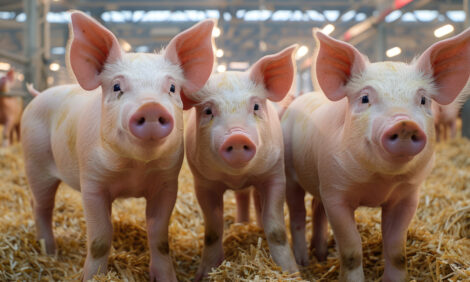



Factors Associated with the Occurrence of MRSA CC398 in Fattening Pigs in Germany
Just over half (52 per cent) of the farms tested had pigs that tested positive for this type of methicillin-resistant Staphylococcus aureus (MRSA), according to researchers at the Federal Institute for Risk Assessment.Katja Alt and colleagues at Germany's Federal Institute for Risk Assessment in Berlin have investigated the prevalence of MRSA in herds of fattening pigs in different regions of Germany. This and their study on the factors associated with the occurrence of this pathogen are published in a paper in BMC Veterinary Research.
The researchers collected pooled dust samples, and a questionnaire covered information regarding herd characteristics and management practices.
Samples were pre-enriched in high-salt medium followed by selective enrichment containing cefoxitin/aztreonam, and culturing. Presumptive colonies were confirmed by multiplex-PCR targeting nuc-, mecA- and 16S rRNA-genes. Isolates were spa- and SCCmec-, and in selected cases, multi-locus sequence-typed.
Susceptibilities to 13 antimicrobials were determined by broth micro-dilution. Statistical analysis was carried out using backward stepwise logistic regression to calculate odds ratios with the MRSA test result as the outcome and herd characteristics as categorical co-variates.
Overall, 152 of 290 (52 per cent) fattening pig farms tested positive for MRSA. The prevalence in the east, north- and south-west of Germany ranged from 39 to 59 per cent. t011 (66 per cent) and t034 (23 per cent) were the most commonly identified spa-types, and 85 per cent of isolates carried SCCmec Type V. Identified spa-types were all associated with clonal complex CC398. Susceptibility testing revealed that all isolates were resistant to tetracycline. High resistance rates were also found for sulfamethoxazole/trimethoprim (40 per cent), and quinupristin/dalfopristin (32 per cent). In addition, 83 per cent of strains displayed multi-drug resistant (>3 substance classes) phenotypes. Logistic regression revealed herd size (large farms OR: 5.4; CI: 2.7-11.2; p<0.05), and production type (wean-to-finish OR: 4.0; CI: 1.6-10.4; p<0.05) as risk factors associated with a positive MRSA finding in fattening pig operations.
MRSA CC398 is widely distributed among herds of fattening pigs in Germany, Alt and colleagues concluded. They added that farm management plays a crucial role in the dissemination of MRSA with herd size, and production type represents potential major indicators.
Reference
Alt K., A. Fetsch, A. Schroeter, B. Guerra, J.A. Hammerl, S. Hertwig, N. Senkov, A. Geinets, C. Mueller-Graf, J. Braeunig, A. Kaesbohrer, B. Appel, A. Hensel and B-A. Tenhagen. 2011. Factors associated with the occurrence of MRSA CC398 in herds of fattening pigs in Germany. BMC Veterinary Research, 7:69 doi:10.1186/1746-6148-7-69
Further Reading
| - | You can view the full report by clicking here. |
January 2012








